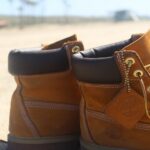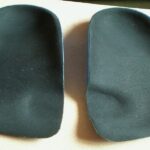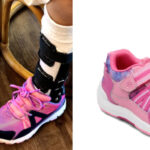Wearing open-toe shoes can be a really great thing, but sometimes they can also be very frustrating. If you’re not careful, your feet will slide forward and the shoe will start to feel uncomfortable. There are some simple ways how to keep feet from sliding forward in open-toe shoes!

This will help absorb moisture before it can start causing problems for you.
Why Your Feet Are Sliding Forward in Open-toe Shoes:
There are many reasons why feet will slide forward in open-toe shoes. Here are some of the most likely ones:
The Foot Is Too Big for the Shoe
You have wide feet and your toes are hitting the front of the shoe or you’re wearing a sandal with straps that don’t provide a lot of support to keep your foot in place.
The Shoe Is Too Tight

Wearing a heel that you’re not used to or trying on shoes with inadequate arch support can cause your feet to slide forward.
There’s nothing under the foot, which makes it difficult for someone who was born flat-footed (no arches) and has no lateral motion control in their toes.
Sweating Foot

If your feet are sweating too much, this can cause them to slide forward in the shoe.
Using High Heel Shoes

If you are not much experienced enough with the high heel shoes, then it is probable that your feet will perspire more. It also happens when you are wearing a pair of heels for an extended period of time without giving them much rest.
Suffering from Hyperhidrosis:
Hyperhidrosis affects many aspects of life including one’s social and professional interactions. The condition can be experienced at any age but most commonly starts during puberty or early adulthood. The problem is not just how someone looks if they suffer this condition; hyperhidrosis causes people to sweat excessively which leads to foot sliding forward on open-toe shoes.This type of sweating usually occurs underarms, palms, soles of feet, earlobes or armpits while some may experience it all over the body. The sufferer may have a heavy or wet sensation on their skin and they will need to change shoes often.Open-toed Shoes: Open toe shoes
How to Keep Feet From Sliding Forward in Open-toe Shoes
Wear socks with your open-toe shoes: Wearing socks with your open-toe shoes is a practical solution for preventing your feet from sliding forward. Socks will prevent your feet from slipping inside your shoe and make a snug fit.
Use a Hairspray to Spray Your Shoes

Spraying your shoes with hairspray is a good method for preventing slippage because it clings to the fabric of your shoe and grips the surface.
Try Taping the Ball of Your Foot to Stop It From Slipping
If you have tried wearing socks with no success, try taping your foot in an attempt to prevent slippage and discomfort. A cotton sock can be worn over top of this tape but there are no guarantees that this will work either.
It’s important to note that some people may find relief by using gel insoles as well which provide extra cushioning underfoot while reducing pressure on sensitive areas like the heel and balls of the feet.
Buy Insoles That Have Arch Support and Cushioning
Gel insoles provide the extra cushioning needed for people who have sensitive feet. These are helpful if you wear high heels often and spend a lot of time on your feet during the day.
Tips:
A good pair of shoes with rubber soles will also help prevent the foot from sliding forward because the fabric grips better without hair spray or any other type of adhesive required.
Cotton Socks

If taping does not work, cotton socks may be another solution to keep slippage at bay as they offer some additional grip that is more reliable than tape or hairspray in most cases.
Try Wearing Heel Grips or Shoe Pads
Heel grips or shoe pads prevent slippage by absorbing the moisture. They can be found in different sizes and shapes, which makes it easier to get a perfect fit for each shoe you own.
Buy Shoes With Better Heel Grip
When buying new shoes or investing in some quality insoles for existing ones, make sure that your foot is not sliding forward when walking because of poor traction on the back of the heels.
Socks Stuffed With Powder Packets
This fixes slippage issues if they are caused by sweat buildup between toes or pressure from too-tight footwear.
Wear socks made out of thicker fabric such as wool or acrylic blends instead of cotton since these materials give more padding around the ball joint than thinner fabrics do.
Apply moleskin, adhesive tape, or non-stick pads to the inside of your heel: These are all effective ways to increase friction between shoe and foot.
Apply Petroleum Jelly Around Toes After a Shower
This will help absorb moisture before it can start causing problems for you.
Use Silicone Gel Arch Support Inserts
If you’re having trouble with high arches that force your toes forward because they need more stability when walking, these should do the trick to keep them in place without being too tight on top of your feet.
Tighten up shoelaces: Tighten up shoelaces so they don’t loosen and slip while you’re wearing them.
Consider Wearing Shoe Inserts
If you’re having trouble with your feet sliding forward, consider using a pair of heel pads or insoles to help keep them in place.
Invest in an Awesome Sandal That Will Stay on No Matter What
The best way to stop this from happening is by investing in an awesome open-toe sandal with enough straps and buckles that it won’t come off when your foot starts sliding around inside the shoe.
Things to Consider Before Purchasing Shoes to Prevent Sliding
Heel Height
The heel on the shoe you’re purchasing should be at least two inches high. If it’s any shorter, your foot will slide around inside the shoe and cause discomfort or blisters.
Style of Shoes
Flat sandals are great for people who have chronic problems with their feet sliding forward in open-toe shoes because they offer more support than other styles of footwear does. By contrast, strappy sandals are best if you want to show off a pedicure while wearing them but may not provide as much stability so consider using inserts to help keep your heels from slipping out.
Material Used in Construction
Leather is one material that has been shown to prevent slippage better than rubber soles.
Footwear With an Insole
The best way to prevent your feet from sliding forward is by choosing shoes that have built-in arch support and/or orthotics, but these can be expensive if you need them for every pair of shoes you purchase. In lieu of this option, shoe inserts are the next best choice since they’re inexpensive and come in many different styles so it’s easy to find one that works well for each individual person.
Choose Shoes With a Thick Sole
Another way to prevent your feet from sliding forward is by wearing shoes with a thick sole. Thicker soles can make it easier for you to stand up and walk around, which reduces the likelihood of slippage, particularly if they are made out of rubber or other materials that have been shown better traction than leather.
Frequently Asked Questions
Why Do My Feet Slide Forward in My Shoes
Your feet may slide forward in your shoes because you are wearing the wrong type of shoe. For example, if you have narrow heels, then your feet will slip forward because they do not have enough support. A wide-based shoe is more stable and provides more support for your feet than a narrow-based shoe.
Should Your Toes Touch the End of Shoes?
It is very important to keep your toes from touching the end of shoes. This prevents unnecessary injuries if you walk and a toe gets caught on the shoe’s edge.
The reason for this is that the friction between your foot and shoe can cause blisters, corns, or calluses on your feet.
If you wear heels, it is especially important to keep your toes away from the end of the shoe so that you don’t risk injuring yourself.
Should You Be Able to Fit a Finger in Your Shoe?
No, a finger should not be able to fit in your shoe. Your foot is larger than your shoe, and you can have a wider range of motion when walking with too-small shoes.
Conclusion
So, how to keep feet from sliding forward in open-toe shoes? My final thought is that you should wear shoes with a thick sole or shoe inserts. You can also use your own bodyweight to help keep feet from sliding forward when wearing open-toe shoes by bending the knees slightly and remaining in place until the point where they’re ready to push off again.
When it comes down to it, there’s no foolproof way to prevent your feet from sliding forward while wearing open-toed shoes as there are too many variables involved for anyone solution on this list alone. However, these strategies go a long way towards minimizing slippage so you’ll be able to see what works best for yourself!





